![]()
![]()
![]()
Use LEFT and RIGHT arrow keys to navigate between flashcards;
Use UP and DOWN arrow keys to flip the card;
H to show hint;
A reads text to speech;
76 Cards in this Set
- Front
- Back
|
Name two ways that herps gain heat energy on a daily basis? |
1. Solar radiation 2. Metabolic heat |
|
|
What are the four other forms (besides solar radiation and metabolic heat) that herps use to gain/lose heat? |
1. Infared radiation 2. Convection 3. Evaporation/condensation 4. Conduction |
|
|
Explain the behaviors performed by a herp that uses solar radiation to heat up and cool down, three behaviors for warming and cooling the body |
Warming - Go into sun -Spread ribs wide -Orient positively (making sure most of body is in the sun= largest shadow) Cooling -Go in shade -Compress ribs -orient negatively (smallest shadow) |
|
|
How can herps use skin coloration to warm/cool off their body temperature using solar radiation? |
Warming -Melanin pigments dispersed (producing dark color) Cooling -Melanin pigments concentrated (producing light coloration) |
|
|
What is infrared radiation and how can herps change the texture of their skin to alter the amount of heat they receive? (Back vs. Belly) |
=Light not visible to our eyes Belly -Shiny, reflects IR radiation Back -matte, absorb/emit IR radiation |
|
|
What is metobolic heat and what is the difference between an endothermy and an ectothermy? |
=Energy produced in the body by chemical reactions Endothermy= warm blooded metabolic energy Ectothermy= temperature controlled by environment |
|
|
T/F: Pythons shiver to create muscle contractions so that they produce heat which makes their internal temperature higher than the environment? |
True, big animals produce metabolic heat so their internal temps are higher than their environment |
|
|
What is convective heat loss/gain? What are two things that herps do to minimize heat loss? |
Gain/loss of heat to surrounding fluid (air or water) 1. Become lower to the ground (being high in canopy= more heat lost) 2. Size, larger herps have larger boundry layers that prevent heat loss compared to smaller herps |
|
|
What is evaporative cooling? What are panting and gular fluttering (reptiles use)? |
=Cooling mechanism pulling heat our of your body -Panting= stick tongue out to have evaporation of liquids -Gular fluttering= Open mouth loosing heat through mouth |
|
|
What is conduction? How do herps warm up and cool down using this method? |
=Heat transfer to/from surfaces Warm up -SA press towards ground Cool down -Majority of SA is off the ground -Lift feet off the ground |
|
|
How do herps use conduction in liquids? |
Water still= conduction Water moving= conduction + convection *position themselves in water column to manage heat gained/given off |
|
|
What does the hypothalamus regulate in herps and how can this differ in herps? |
=Senses and monitors their temperature -Temperature preference varies between species biased on activity levels (female vs. male, season, digestion, pregnant, sick) |
|
|
What are the three techniques used by herps to regulate their internal temperature for heating faster? |
1. Increase heartbeat 2. Increase blood to skin and decrease blood to lungs 3. Dilate vessels in warm parts of body (limbs) |
|
|
T/F: Thermoregulation is easier in forests where it doesnt take much energy to get warmed by the sun? |
False, this is true for desert environments but in forests thermoregulation is hard because sunlight is not cheap |
|
|
What are the two options that herps can choose from under cold temperatures so that they can survive? |
Option 1: Super cooling -Have dissolved solutes floating around in the blood which lowers their internal freezing point Option 2: Actually freezing -They increase the osmolality of their cells using glucose (anti-freeze agent) which will dehydrate the cells but will allow them to stay alive for about a week without a heartbeat |
|
|
What is the difference between performance and entergetics? |
Per= what the animal is doing? and how well they are doing that? Enter= Energy flow through system (food eaten, activities performed) *be sure to be able to draw the speed vs. VO2 and Metobolic rate vs. temp graphs |
|
|
What are the three modifications that frogs have made to their trunk muscles to improve frog calling? |
Trunk muscles become 1. huge 2. highly oxidative 3. full of lipids & glycogen (fuel) because calling is very expensive |
|
|
Draw the performance vs. temperature curve and include ( thermal optimum, too hot/cold temps, OK ranges temps) |
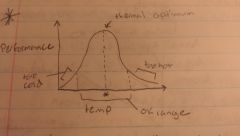
|
|
|
What are the seven factors that affect metabolism? |
1. temp 2. moisture 3. genetics 4. ecological opportunity 5. metabolize (anaerobic, aerobic) 6. respire O2 7. eating |
|
|
What does reaction force mean when refering to herps locomotion? Use the line diagram to visualize this concept including: reaction force, propulsion, vertical and force |
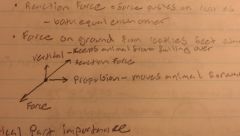
Force pushes on reptiles feet to make them move |
|
|
T/F: Since herps are in the push-up position all of the time they are loosing lots of energy to support themselves? |
True, herps tend to rest their bellies on the ground to save energy |
|
|
What is lateral undulation in regards to locomotion? |
Keeps the spine & center of mass over the limbs that are in contact with the ground |
|
|
What is the lateral footfall locomotion pattern? |
Feet on the same side of the body touch the ground at the same time starting with the back feet to the front. So 1, 2 then 3, 4 |
|
|
What is the diagonal footfall locomotion pattern? |
Opposite limbs/feet on each side move together, so 1, 3 then 2, 4 move. This can be unstable which can lead to them standing on two legs and running. |
|
|
Define each of these terms relating to locomotion: -Duty factor -Gait -Gait cycle |
Duty= How long are the feet in contact with the ground (leaping vs. running) Gait= includes both footfall patterns and duty factor (walk, run, skip) -Cycle= one complete sequence of footfalls (all feet touching ground once for one cycle) |
|
|
Explain or draw the four modes of locomotion and limb orientation that herps use to move? (femur rotation, pelvic rotation, femur retraction, all 3 together) |
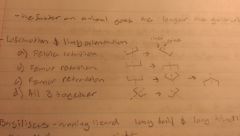
|
|
|
What is unique about the basiliscus (jesus lizard) and how are they able to perform this task? |
Run upright over water They are equally above the water than below the water making them at equilibrium. Basically they slap the water and create an air pocket within the water where they can pull their foot out very easy |
|
|
How does lateral undulation work for snakes? |
They apply force at two points of contact on the same side of their body during one wavelength which propels them forward. the wave on the other side of the body doesn't produce any force on the ground |
|
|
How does concertina locomotion work for snakes? |
The front part of the body becomes anchored which causes the back part of the body to move and the same thing happens when the back part of the body is anchored |
|
|
How does sidewinding locomotion work for snakes? |
"roll along" the surface They lift their body at the two points of contact with the ground, these two points are what makes the body move forward |
|
|
How does rectilinear locomotion work in snakes? |
"inch worm like" move muscles forward which pulls the skin/ribs/gut |
|
|
How does internal concertina work in cacilians? |
Skin pushes out, pulls spine forward which pulls the herp forward *this is different from retilinear because there is side to side spine movement |
|
|
T/F: Aquatic snakes have all points on the entire surface of their body generating drag? |
True, they use lateral undulation to move in water |
|
|
How is home range size decided? (small vs. large vs. nomads) |
small -resources are abundant and/or resources are replenished quickly large -resources are sparse and/or replenished slowly nomads -resources extremely sparse and resources replenish very slowly |
|
|
When is a territory worth defending? |
When resources are moderately abundant, evenly distributed/ moderately patchy and rapidly renewing |
|
|
Why are patch resources and sparse resources not worth defending? |
Patch= lots of food in one place & lots of animals in that area, so it would be hard to defend Sparse= cant defend areas within a large home range since you cant see everything that is happening over that range |
|
|
T/F: Homing behavior is a characteristic of individuals that are not territorial? |
False, these territorial animals will return to areas with rich resources to defend because it will be more beneficial for them |
|
|
What is the difference between visual, chemical, magnetic and generic homing behavior? |
Visual= move landmark to landmark to find home range Chemical= chemical ques lead these animals back to home range Generic= head downhill towards desirable habitat or towards reflected light off horizon Magnetic= use an internal compass to find way home biased on earths magnetic fields |
|
|
How can celestial cues help herps find home range? |
Use the position of the sun to tell the time of day it is |
|
|
What is the pineal complex? How can the parietal organ help the pineal complex? |
This detects photoperiod (how long light has been out) to tell what time of day it is. -This organ is located on the top of the head ("third eye") that aids in detecting light better also being able to see polarize light |
|
|
Re-create how turtles recognize where their home is in a graph format shown in lab, include: horizontal component, surface of earth, total field intensity, inclination angle, vertical component. |
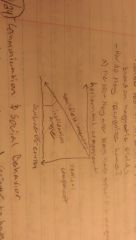
|
|
|
What are the two things required to have effective communication? |
Signaler and reciever |
|
|
What is acoustic communication and what are three ways herps can perform this? |
=Use of sound waves 1. vocalizations 2. Slapping of water surface/any surface 3. Rubbing of body parts |
|
|
What are two advantages and three disadvantages of acoustic communication? |
Adv 1. good for long distances 2. Can use during night and dusk (not limited by light) Dis 1. Too cold = lower rate of calling 2. Too hot= shorter call duration 3. Ambient noise= can diminish the effectiveness of communication |
|
|
What are the two ways that herps can show visual communication? |
1. Directed body movements 2. Coloration of body |
|
|
What is one advantage and two disadvantages for visual communication? |
Adv 1. Good for short distances Dis 1. Light conditions -low light dewlaps (white, yellow, pink) -bright light dewlaps (red, blue, purple) 2. Environmental complexity= the more complexity the harder the communication will be |
|
|
Regarding chemical comunication, explain what each receivers epithelia is used for: olfactory, vomeronasal, taste buds |
Olfactory= small airborne (volitile) molecules Vomeronasal= large non-volitile molecules, signals stay on surfaces Taste buds= tasting things with mouth |
|
|
What is one advantage and two disadvantages to chemical communication? |
Adv 1. Long lasting, can mark territories for a long time Dis 1. Can dissipate in the environment 2. Cannot be complex messages |
|
|
What is tactile communication and is it a form of primary or secondary communication? |
Use of body parts coming in contact with another individual (this can include waves sent through the water or objects). Form of secondary communication |
|
|
What is one advantage and two disadvantages for tactile communication? |
Adv 1. Good for short distances Dis 1. Can be dangerous 2. Barriers to contact that prevent them from touching |
|
|
What form of communication do frogs and toads use and what do they use to project their calls? |
Acoustic com. -done by males and they use vocal sacks -use of bucal pumping/airflow (look up in notes how process works
|
|
|
What are the two types of vocal sacks that frogs use? |
1. subgular= one sack that comes out from underneath head 2. lateral= paired sacks that exit from sides of head |
|
|
Explain each type of call used by anurans: -Advertisement -Reciprocation -Release -Distress |
Adv= males display calls to females Reci= only ways females vocalize, very rare, used to respond to male calls Rel= male accidentally grabs another male for amplexus and that male tells him to get off Dist= males use when they are grabbed by a predator (loud) |
|
|
What two forms of communication do salamanders use and what structure do they use to filter the information they have recieved? |
Chemical and tactile communication -Nasolabial groove |
|
|
What form of communication do squamates use? |
Visual communication but they can also use tactile, chemical and acousitc |
|
|
What four types of communication (not the broad groups) are crocodiles known to use? |
1. Advertisement (mating or territory response) 2. Aggression (towards other males) 3. Courtship (male to females) 4. Parent/offspring (specific sounds that only have meaning to parents and other siblings) |
|
|
What are the three things that herps have to think about before mating? |
1. Investment 2. Probability of fertilization 3. Availability of mates |
|
|
What is the operational sex ratio (OSR)? |
Ratio of males to fertilize females at a given time, probably not going to find a perfect 50:50 split between genders |
|
|
Graph each fecundity vs. mating sucess graph for each of the four types of mating styles: Polygamy, Polygyny, Polyandry, Monogamy |
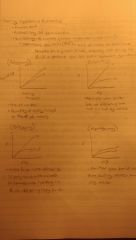
|
|
|
What is the main difference between Polygyny and Polyandry? |
Polygyny= parental investment by females Polyandry= parental investment by males |
|
|
Salamanders exhibit polygamy, so how do aquatic and terrestrial salamanders differ? |
Aquatic= explosive breeders Terrestrial= prolonged breeders |
|
|
What are pair bonds exhibited by frogs? |
Monogamy, eggs hatch and males carry the offspring to another location to develop (high parental investment) |
|
|
T/F: Lizards can exhibit polygamy by using one male that fertilizes multiple females? |
False, this is referred to as polygyny. Polygamy in lizards is sperm competition and clutches with multiple paternities |
|
|
What are satellite males for frogs/amphibians? what is clutch piracy? |
Satellite= other males wait quietly to the side until a female comes in response to a dominate males calls where he sneaks in to mate with the female Clutch p= when two frogs are in amplexus another male mounts the male in amplexus and fertilizes about 10% of the eggs in that clutch |
|
|
What are some characteristics of sit and wait foragers? |
Cryptic coloration, less active, eat more mobile prey, lower body temps |
|
|
What are some characteristics of active foragers? |
Chase down prey, use stealth, mobile, eat sedentary prey (prey that hides), high body temps |
|
|
T/F: Camellias use both monocular and binocular vision rather than most herps that use binocular vision? |
True they can screen for prey using mono vision then zero in on their target with their binocular vision |
|
|
What are the integomentary sense organs (ISO's) located on crocodiles and alligators? |
Sense cells on lower jaw of mouth -alligators only have these on their mouth -crocodiles have these on mouth and along most of their body which could mean they function as a salinity detection device |
|
|
When trying to capture moving prey is it better to be a chase feeder or a strike feeder? |
Chase, because they actively chase after their food while strike herps move their bodies to the strike (the strike is a much faster attack than the chase attack tho) |
|
|
What is the difference between inertial feeding and hyoid-toungue retraction? |
Inertial= moving body over prey (prey stays in same place) Hyoid= manipulating prey into your mouth with your tongue into your esophagus |
|
|
What is tongue prehension? |
Use of the tongue to grab prey and pull the prey into your mouth |
|
|
Explain the difference between the catipulte and balistic tongue methods? |
Catipulte= works like a catipulte with a hindge in middle of tongue balistic= works like a sling shot |
|
|
T/F: Constriction is used to cut off the cirrculation of the prey item not to squeeze the prey to death? |
True, the snakes are trying to prevent blood from getting to the heart |
|
|
Glands used to deliver toxins are ___________ where toxins overall have evolved ___ over time from a common ancestor. a) derived, 1 b) derived, 2 c) ancestral, 1 d) ancestral, 2 |
D |
|
|
Why is it an advantage to have a channel on the inside of your fangs rather than a groove running the rear part of the fang? |
That channel speeds up the delivery of venom into the prey (more directed delivery system) |
|
|
T/F: the type of diet that a herp has is constrained by its evolutionary history? |
True what its ancestors fed on is a good indication of what the derived herp will eat |

